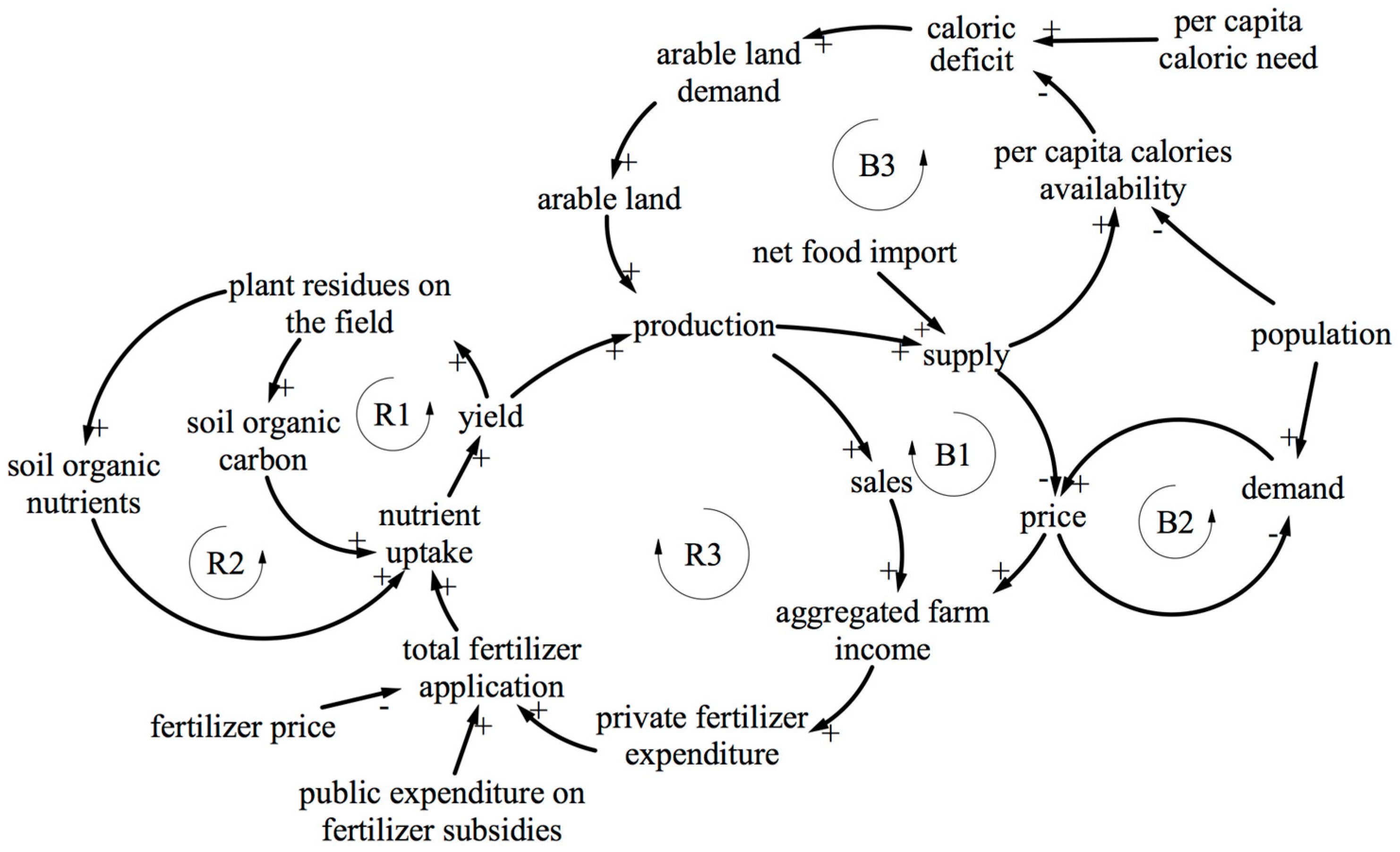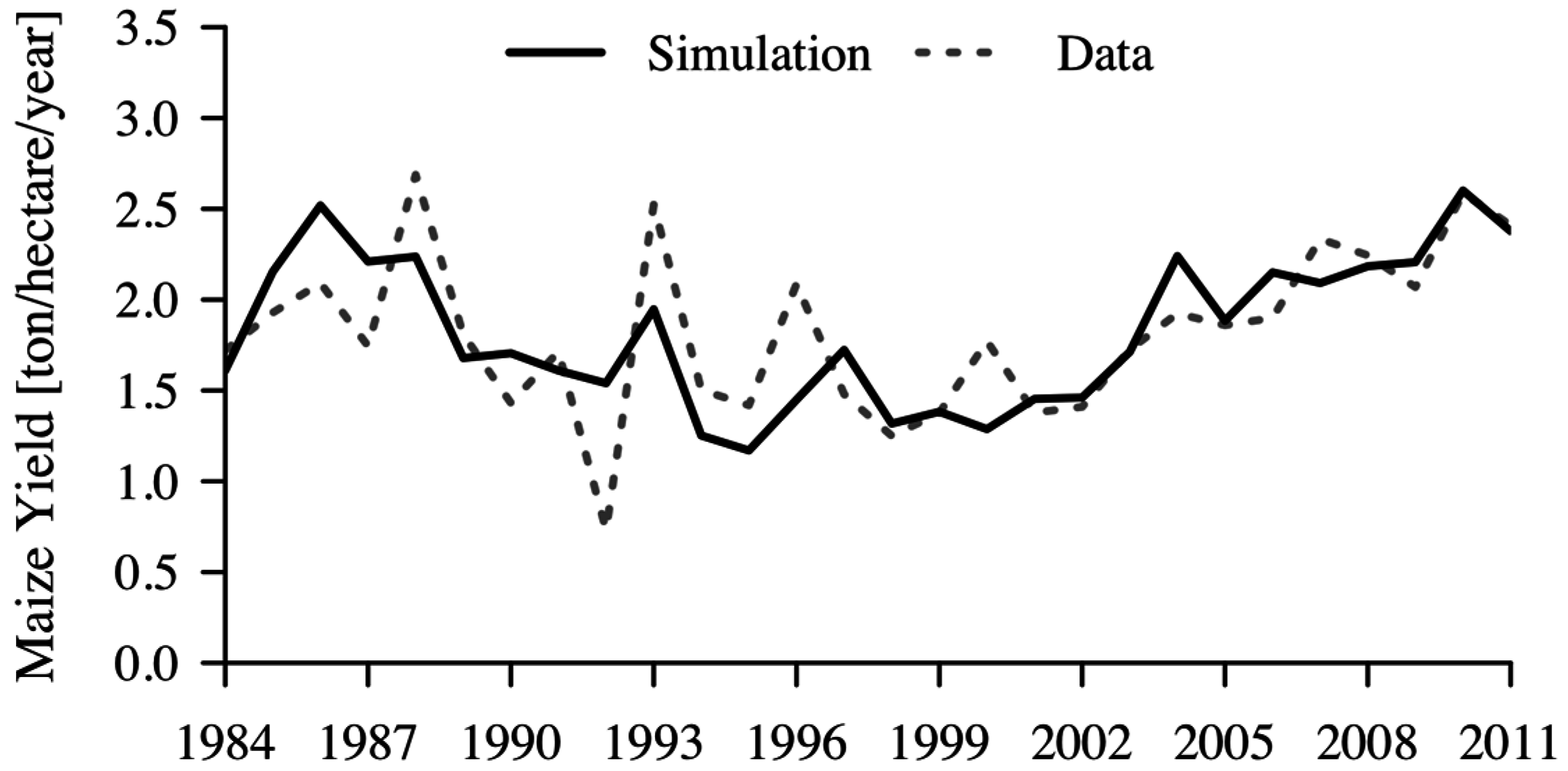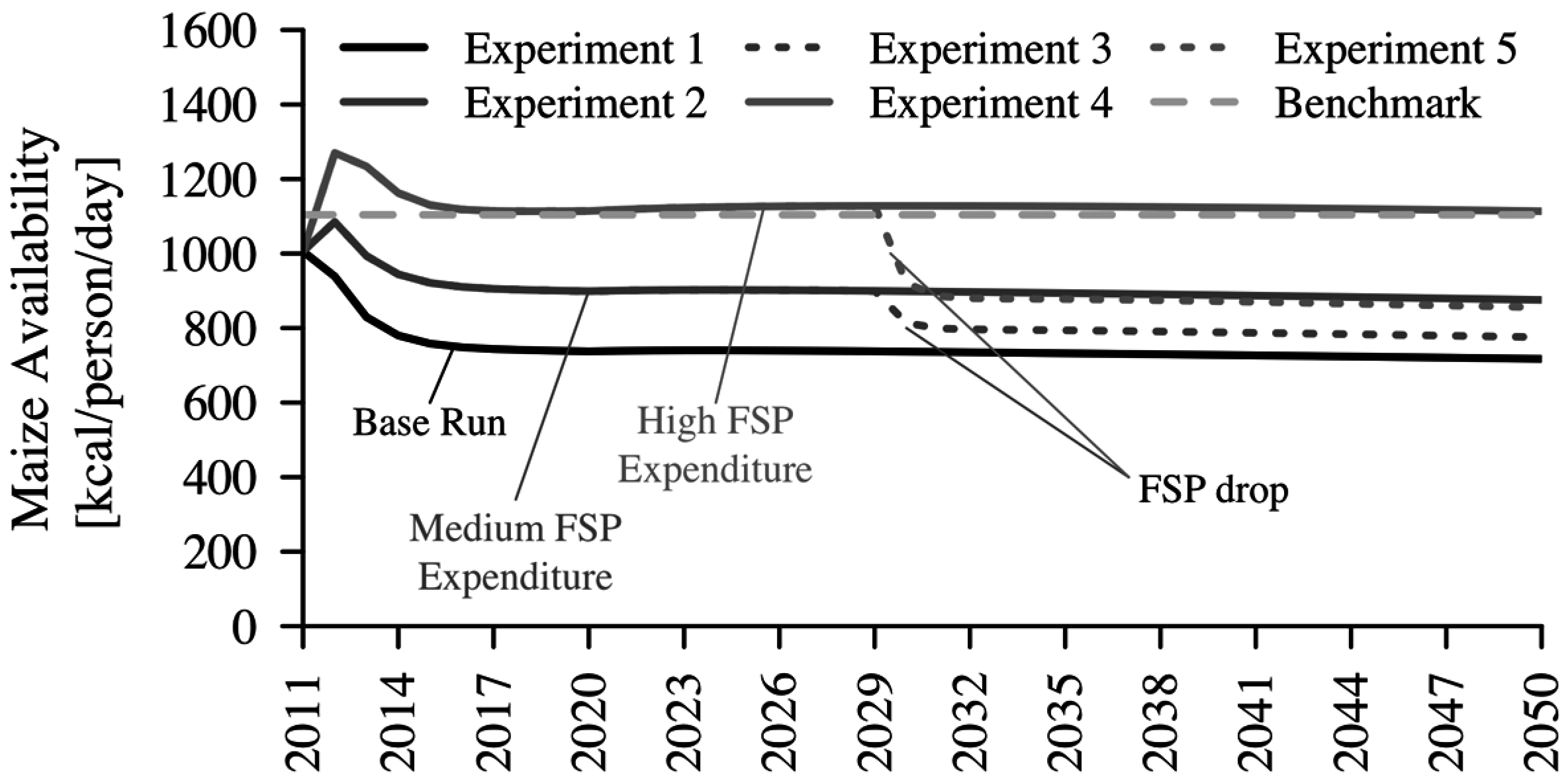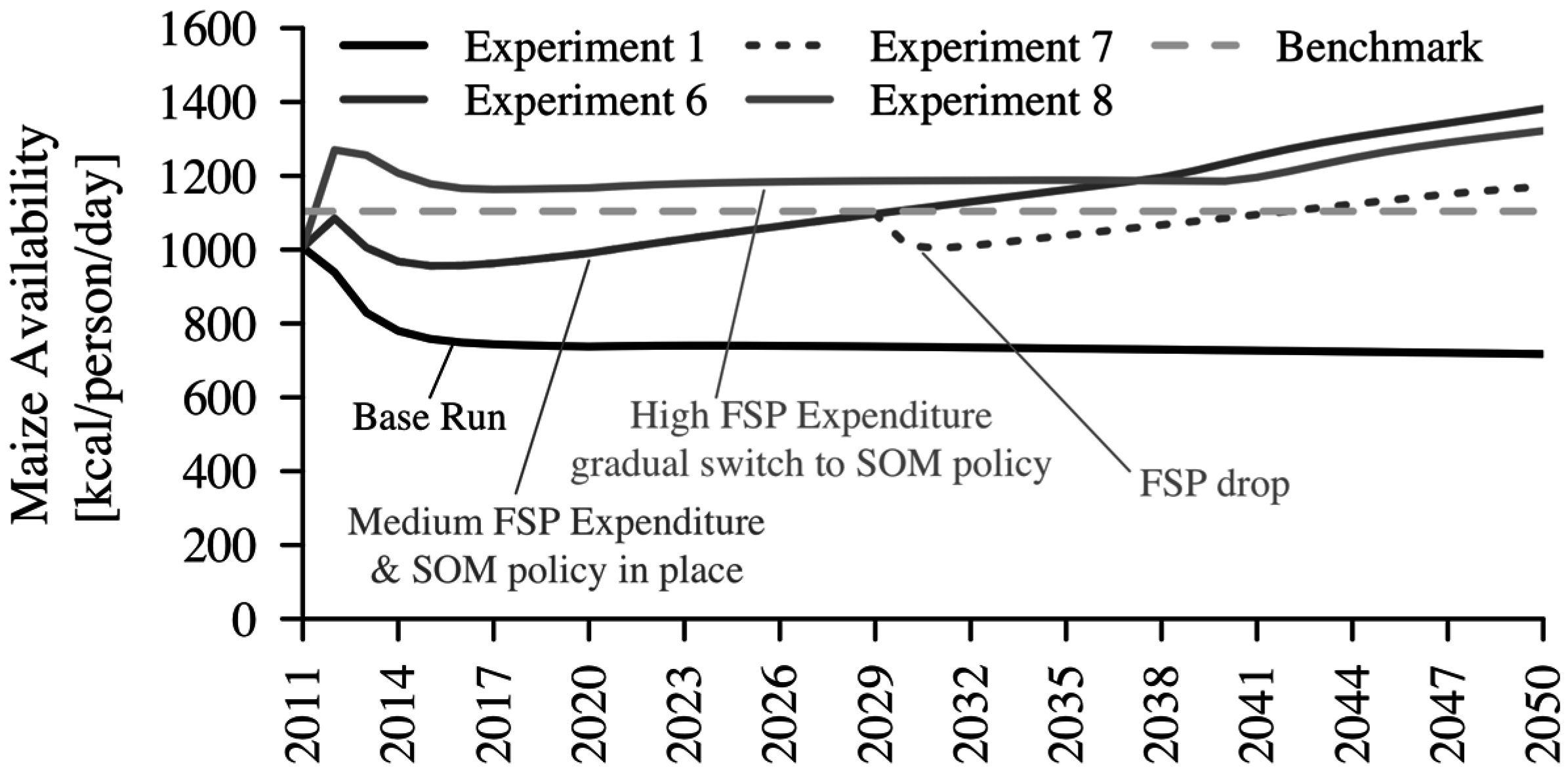Short-Term Success versus Long-Term Failure: A Simulation-Based Approach for Understanding the Potential of Zambia’s Fertilizer Subsidy Program in Enhancing Maize Availability
Abstract
:1. Introduction
2. Method and Study Case
2.1. Simulation Approach
2.2. Zambia’s Fertilizer Subsidy Program
3. Modeling Framework
3.1. Fertilizer, Yield, and Soil Dynamics
3.2. Supply and Demand Dynamics
3.3. Self-Consumption and Land Dynamics
3.4. Summary
4. Model Specification
4.1. Fertilizer, Yield and Soil Dynamics
4.2. Supply and Demand Dynamics
4.3. Land Dynamics
5. Calibration, Validation and Past Trajectories
6. Model Analysis
6.1. Analysis of Mechanisms
6.2. Analysis of Key Variables
7. Discussion and Conclusions
Supplementary Materials
Acknowledgments
Conflicts of Interest
References
- Banful, A.B. Old problems in the new solutions? Politically motivated allocation of program benefits and the “new” fertilizer subsidies. World Dev. 2011, 39, 1166–1176. [Google Scholar] [CrossRef]
- Jayne, T.S.; Rashid, S. Input subsidy programs in Sub-Saharan Africa: A synthesis of recent evidence. Agric. Econ. 2013, 44, 547–562. [Google Scholar] [CrossRef]
- Morris, M.; Kelly, V.A.; Kopicki, R.J.; Byerlee, D. Fertilizer Use in African Agriculture: Lessons Learned and Good Practice Guidelines; The World Bank: Washington, DC, USA, 2007. [Google Scholar]
- Mason, N.M.; Jayne, T.S.; Mofya-Mukuka, R. Zambia’s input subsidy programs. Agric. Econ. 2013, 44, 613–628. [Google Scholar] [CrossRef]
- Jayne, T.S.; Mather, D.; Mason, N.; Ricker-Gilbert, J. How do fertilizer subsidy programs affect total fertilizer use in Sub-Saharan Africa? Crowding out, diversion, and benefit/cost assessments. Agric. Econ. 2013, 44, 687–703. [Google Scholar] [CrossRef]
- Dorward, A.; Chirwa, E. The Malawi agricultural input subsidy program: 2005/06 to 2008/09. Int. J. Agric. Sustain. 2011, 9, 232–247. [Google Scholar] [CrossRef]
- Mason, N.M.; Tembo, S.T. Is FISP Reducing Poverty among Smallholder Farm Households in Zambia? Indaba Agricultural Policy Research Institute: Lusaka, Zambia, 2015. [Google Scholar]
- Druilhe, Z.; Barreiro-Hurlé, J. Fertilizer Subsidies in Sub-Saharan Africa; Food and Agriculture Organization (FAO) Agricultural Development Economics Division: Rome, Italy, 2012. [Google Scholar]
- Denning, G.; Kabambe, P.; Sanchez, P.; Malik, A.; Flor, R.; Harawa, R.; Nkhoma, P.; Zamba, C.; Banda, C.; Magombo, C.; et al. Input subsidies to improve smallholder maize productivity in Malawi: Toward an African green revolution. PLoS Biol. 2009, 7, 2–10. [Google Scholar] [CrossRef] [PubMed]
- Jayne, T.S.; Govereh, J.; Wanzala, M.; Demeke, M. Fertilizer market development: A comparative analysis of Ethiopia, Kenya, and Zambia. Food Policy 2003, 28, 293–316. [Google Scholar] [CrossRef]
- Tully, K.; Sullivan, C.; Weil, R.; Sanchez, P. The state of soil degradation in Sub-Saharan Africa: Baselines, trajectories, and solutions. Sustainability 2015, 7, 6523. [Google Scholar] [CrossRef]
- Shitumbanuma, V.; Chikuta, F. Nutrient Status of the Major Agricultural Soils of the Eastern Province of Zambia; The International Institute of Tropical Agriculture: Lusaka, Zambia, 2013. [Google Scholar]
- Kumwenda, J.D.T.; Waddington, S.R.; Snapp, S.S.; Jones, R.B.; Blackie, M.J. Soil fertility management in southern Africa. In Africa’s Emerging Maize Revolutaion; Byerlee, D., Eicher, C.E., Eds.; Lynne Rienner Publishers Inc.: Boulder, CO, USA, 1997. [Google Scholar]
- Crawford, E.W.; Kelly, V.; Jayne, T.S.; Howard, J. Input use and market development in Sub-Saharan Africa: An overview. Food Policy 2003, 28, 277–292. [Google Scholar] [CrossRef]
- Crawford, E.W.; Jayne, T.S.; Kelly, V.A. Alternative Approaches for Promoting Fertilizer Use in Africa; The World Bank: Washington, DC, USA, 2006. [Google Scholar]
- Stave, K. Participatory system dynamics modeling for sustainable environmental management: Observations from four cases. Sustainability 2010, 2, 2762. [Google Scholar] [CrossRef]
- Sterman, J.D. Business Dynamics; McGraw-Hill Inc.: New York City, NY, USA, 2000. [Google Scholar]
- Barlas, Y. Formal aspects of model validity and validation in system dynamics. Syst. Dyn. Rev. 1996, 12, 183–210. [Google Scholar] [CrossRef]
- Flynn, H.; Breger, D.; Belden, A.; Bier, A.; Laurent, C.; Andrews, N.; Rickerson, W. System dynamics modeling of the Massachusetts SREC market. Sustainability 2010, 2, 2746. [Google Scholar] [CrossRef]
- Food and Agriculture Organization. Food balance sheet. Available online: http://faostat.fao.org/site/368/default.aspx#ancor (accessed on 15 April 2015).
- Tembo, S.; Sitko, N. Technical Compendium: Descriptive Agricultural Statistics and Analysis for Zambia; Indaba Agriculture Policy Research Institute: Lusaka, Zambia, 2013. [Google Scholar]
- Wood, A.P.; Kean, S.A.; Milimo, J.T.; Warren, D.M. The Dynamics of Agricultural Policy and Reform in Zambia; Iowa State University Press: Ames, IO, USA, 1990. [Google Scholar]
- Heady, E.O.; Dillon, J.L. Agricultural Production Functions; Iowa State University Press: Ames, IO, USA, 1961. [Google Scholar]
- Scheffer, F.; Schachtschabel, P. Lehrbuch der Bodenkunde, 16th Auflage ed.; Spektrum Akademischer Verlag, Springer: Heidelberg, Germany, 2010. [Google Scholar]
- Schilling, G. Pflanzenernährung und Düngung; Eugen Ulmer Verlag: Stuttgart, Germany, 2000. [Google Scholar]
- Varian, H.R. Grundzüge der Mikroökonomik; Oldenbourg Wissenschaftsverlag GmbH: Munich, Germany, 2007. [Google Scholar]
- Henrichsmeyer, W.; Witzke, H.P. Agrarpolitik Band 1 Agrarökonomische Grundlagen; Eugen Ulmer GmbH & Co.: Stuttgart, Germany, 1991. [Google Scholar]
- Meadows, D.L. Dynamics of Commodity Production Cycles; Wright-Allen Press: Cambridge, MA, USA, 1970. [Google Scholar]
- Johnston, A.E.; Poulton, P.R.; Coleman, K. Soil organic matter: Its importance in sustainable agriculture and carbon dioxide fluxes. Adv. Agron. 2009, 101, 1–57. [Google Scholar]
- Oberholzer, H.R.; Leifeld, J.; Mayer, J. Changes in soil carbon and crop yield over 60 years in the Zurich organic fertilization experiment, following land-use change from grassland to cropland. J. Plant Nutr. Soil Sci. 2014, 177, 696–704. [Google Scholar] [CrossRef]
- Chapoto, A.; Haggblade, S.; Hichaambwa, M.; Kabwe, S.; Longabaugh, S.; Sitko, N.; Tschirley, D. Agricultural Transformation in Zambia: Alternative Institutional Models for Accelerating Agricultural Productivity Growth and Commercialization; Indaba Agricultural Policy Research Institute: Lusaka, Zambia, 2012. [Google Scholar]
- Lambin, E.F.; Turner, B.L.; Geist, H.J.; Agbola, S.B.; Angelsen, A.; Bruce, J.W.; Coomes, O.T.; Dirzo, R.; Fischer, G.; Folke, C.; et al. The causes of land-use and land-cover change: Moving beyond the myths. Glob. Environ. Chang. 2001, 11, 261–269. [Google Scholar] [CrossRef]
- De Vries, B. Sustainability Science; Cambridge University Press: Cambridge, UK, 2012. [Google Scholar]
- Ventana. Vensim; Ventana Systems, Inc.: Harvard, MA, USA, 2013. [Google Scholar]
- Burke, W.J.; Jayne, T.S.; Chapoto, A. Factors Contributing to Zambia’s 2010 Maize Bumper Harvest; Indaba Agricultural Policy Research Institute: Lusaka, Zambia, 2010. [Google Scholar]
- International Panel on Climate Change. IPCC Guidelines for National Greenhouse Gas Inventories; International Panel on Climate Change: Geneva, Switzerland, 2006; Chapter 11. [Google Scholar]
- Food and Agriculture Organization. Population Estimates and Projections. Available online: http://faostat.fao.org/site/550/default.aspx#ancor (accessed on 20 November 2014).
- Food and Agriculture Organization. Production Series. Available online: http://faostat.fao.org/site/567/default.aspx#ancor (accessed on 11 November 2014).
- Food and Agriculture Organization. Resource Series. Available online: http://faostat.fao.org/site/674/default.aspx (accessed on 20 November 2014).
- Kumar, S.K. Design, Income distribution, and consumption effects of maize pricing policies in Zambia. In Food Subsidies in Developing Countries; Johns Hopkins University Press: Baltimore, MD, USA, 1988; pp. 289–300. [Google Scholar]
- Mason, N.M.; Myers, R.J. The effects of the food reserve agency on maize market prices in Zambia. Agric. Econ. 2013, 44, 203–216. [Google Scholar] [CrossRef]
- Ministry of Agriculture and Cooperatives. Provincial Prices from 1994 to 2012; Ministry of Agriculture and Cooperatives: Lusaka, Zambia, 2014.
- Howard, J.A.; Chitalu, G.M.; Kalonge, S.M. The Impact of Investments in Maize Research and Dissemination in Zambia Part One: Main Report; Michigan State University: East Lansing, MI, USA, 1993. [Google Scholar]
- Zulu, B.; Nijhoff, J.J.; Jayne, T.S.; Negassa, A. Is the Glass Half Empty or Half Full? An Analysis of Agricultural Production Trends in Zambia; Zambia Food Security Research Project: Lusaka, Zambia, 2000. [Google Scholar]
- Chiwele, D.; Fowler, M.; Humphrey, E.; Hurrell, A.; Willis, J. Agriculture Case Study. Evaluation of Budget Support in Zambia; Oxford Policy Management: Oxford, UK, 2010. [Google Scholar]
- Government of the Republic of Zambia. Estimates of Revenue and Expenditure (including Capital and Constitutional and Statutory Expenditure); Government of the Republic of Zambia: Lusaka, Zambia, 2014.
- Zambia Meteorological Department. Monthly Precipitation Data; Zambia Meteorological Department: Lusaka, Zambia, 2014.
- Food and Agriculture Organization. Emission Series. Available online: http://faostat.fao.org/site/704/default.aspx (accessed on 11 November 2014).
- International Fertilizer Development Center. Zambia Fertilizer Assessment; International Fertilizer Development Center: Muscle Shoals, AL, USA, 2013. [Google Scholar]
- Central Statistical Office. Crop Forecast Survey; Central Statistical Office: Lusaka, Zambia, 2014.
- Xu, Z.; Guan, Z.; Jayne, T.S.; Black, R. Factors influencing the profitability of fertilizer use on maize in Zambia. Agric. Econ. 2009, 40, 437–446. [Google Scholar] [CrossRef]
- Sterman, J.D. Appropriate summary statistics for evaluating the historical fit of system dynamics models. Dynamica 1984, 10, 51–66. [Google Scholar]
- Lunduka, R.; Ricker-Gilbert, J.; Fisher, M. What are the farm-level impacts of Malawi’s farm input subsidy program? A critical review. Agric. Econ. 2013, 44, 563–579. [Google Scholar] [CrossRef]
- Place, F.; Barrett, C.B.; Freeman, H.A.; Ramisch, J.J.; Vanlauwe, B. Prospects for integrated soil fertility management using organic and inorganic inputs: Evidence from smallholder African agricultural systems. Food Policy 2003, 28, 365–378. [Google Scholar] [CrossRef]
- Vanlauwe, B.; Giller, K.E. Popular myths around soil fertility management in Sub-Saharan Africa. Agric. Ecosyst. Environ. 2006, 116, 34–46. [Google Scholar] [CrossRef]
- Sterman, J.D. Does formal system dynamics training improve people’s understanding of accumulation? Syst. Dyn. Rev. 2010, 26, 316–334. [Google Scholar] [CrossRef]






| Data Series | Usage | Sources |
|---|---|---|
| Population | Model input & scenario | [37] |
| Maize yield | Calibration | [38] |
| Maize production | Calibration | [38] |
| Arable land | Calibration | [38] |
| Maize trade | Model input & scenario | [20] |
| Land use | Calibration | [39] |
| Maize prices | Calibration | [22,40,41,42] |
| Fertilizer use | Calibration | [39] |
| Fertilizer prices | Model input & scenario | Estimated from [42] |
| Fertilizer subsidies | Model input & scenario | [22,43,44,45,46] |
| Precipitation | Model input & scenario | [47] |
| Manure application | Model input & scenario | [48] |
| Soil organic matter | Calibration | Qualitative, [49] |
| Maize sales | Calibration | [22,50] |
| Constant | Value |
|---|---|
| c1 (yield coefficient of nitrogen) | 4.03 (ha·year/ton) |
| c2 (yield coefficient of water) | 0.004 (year/mm) |
| ε (price sensitivity to supply-demand imbalances) | −0.86 |
| Pref (reference producer maize price) | 55 (ZMK/kg) |
| tmin (mineralization time of SOM) | 31 (year) |
| PCCN (per capita calories need) | 2200 (kcal/person/day) |
| Plant residues removed from field | 70 (%) |
| Seed requirement | 0.03 (ton/ha/year) |
| Demand sensitivity to consumer price | −0.1 |
| RMSPE | U(M) | U(S) | U(C) | R2 |
|---|---|---|---|---|
| 0.254 | 0.000 | 0.014 | 0.986 | 0.521 |
| EXPN | FSPE | FSPD | SOMP | Description |
|---|---|---|---|---|
| E1 | 0 | Constant | No | Base run: no policy in place |
| E2 | 1.9810 | Constant | No | Medium FSPE 1; Extrapolation of the status quo |
| E3 | 1.9810 | Drop in 2030 | No | Medium FSPE; FSP removed in 2030 |
| E4 | 4.5010 | Constant | No | High FSPE |
| E5 | 4.5010 | Drop in 2030 | No | High FSPE; FSP removed in 2030 |
| E6 | 1.9810 | Constant | Yes | Medium FSPE & addition of SOM |
| E7 | 1.9810 | Drop in 2030 | Yes | Medium FSPE, addition of SOM; FSP removed in 2030 |
| E8 | 4.5010 | Linear fall | Yes | High FSPE, addition of SOM; FSP gradually removed |
| EXPN | Fertilizer Use | Soil Organic Matter | Maize Yield | Maize Production | Maize Availability | |
|---|---|---|---|---|---|---|
| E1 | Value | 28,916 | 44 | 1.5 | 3.8 | 717 |
| E2 | Value | 44,061 | 49 | 1.9 | 4.6 | 876 |
| Change to E1 | +52% | +11% | +21% | +22% | +22% | |
| E3 | Value | 30412 | 47 | 1.7 | 4.1 | 776 |
| Change to E1 | +5% | +6% | +8% | +8% | +8% | |
| E4 | Value | 65617 | 56 | 2.4 | 5.9 | 1114 |
| Change to E1 | +127% | +26% | +53% | +55% | +55% | |
| E5 | Value | 32468 | 51 | 1.8 | 4.5 | 856 |
| Change to E1 | +12% | +15% | +19% | +19% | +19% | |
| E6 | Value | 47255 | 69 | 2.7 | 6.4 | 1382 |
| Change to E1 | +63% | +56% | +78% | +69% | +93% | |
| E7 | Value | 40545 | 66 | 2.5 | 6.2 | 1171 |
| Change to E1 | +40% | +49% | +62% | +63% | +63% | |
| E8 | Value | 37833 | 71 | 2.7 | 6.3 | 1322 |
| Change to E1 | +31% | +60% | +74% | +68% | +84% |
© 2016 by the author; licensee MDPI, Basel, Switzerland. This article is an open access article distributed under the terms and conditions of the Creative Commons Attribution (CC-BY) license (http://creativecommons.org/licenses/by/4.0/).
Share and Cite
Gerber, A. Short-Term Success versus Long-Term Failure: A Simulation-Based Approach for Understanding the Potential of Zambia’s Fertilizer Subsidy Program in Enhancing Maize Availability. Sustainability 2016, 8, 1036. https://doi.org/10.3390/su8101036
Gerber A. Short-Term Success versus Long-Term Failure: A Simulation-Based Approach for Understanding the Potential of Zambia’s Fertilizer Subsidy Program in Enhancing Maize Availability. Sustainability. 2016; 8(10):1036. https://doi.org/10.3390/su8101036
Chicago/Turabian StyleGerber, Andreas. 2016. "Short-Term Success versus Long-Term Failure: A Simulation-Based Approach for Understanding the Potential of Zambia’s Fertilizer Subsidy Program in Enhancing Maize Availability" Sustainability 8, no. 10: 1036. https://doi.org/10.3390/su8101036
APA StyleGerber, A. (2016). Short-Term Success versus Long-Term Failure: A Simulation-Based Approach for Understanding the Potential of Zambia’s Fertilizer Subsidy Program in Enhancing Maize Availability. Sustainability, 8(10), 1036. https://doi.org/10.3390/su8101036






